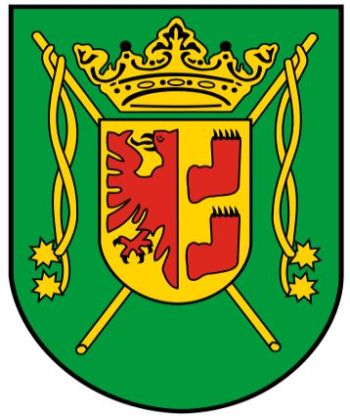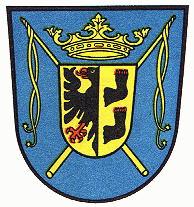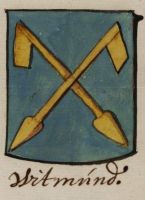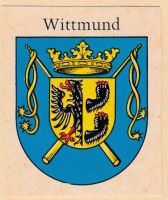Wittmund: Difference between revisions
Jump to navigation
Jump to search
Knorrepoes (talk | contribs) m (Text replacement - "|'''English''' ↵| {{blazon wanted}}" to "|'''English''' | blazon wanted") |
Knorrepoes (talk | contribs) No edit summary |
||
| Line 1: | Line 1: | ||
{| class="wikitable" | |||
|- style="vertical-align:top;" | |||
|[[File:wittmund1.jpg|center|350 px|alt=Wappen von {{PAGENAME}}/Arms (crest) of {{PAGENAME}}]] | |||
| | |||
<center>''' {{uc:{{PAGENAME}}}} '''</center><br> | |||
'''Country''' : Germany [[File:germany.jpg|60 px|right]]<br><br><br><br> | |||
'''State''' : [[Niedersachsen]][[File:Niedersachsen.jpg|60 px|right]]<br><br><br><br> | |||
'''District (Kreis)''' : [[Wittmund (kreis)|Wittmund]][[File:Wittmund.kreis.jpg|60 px|right]]<br><br><br><br> | |||
'''Additions''':<br> | |||
* 1972 Ardorf | |||
* 1972 [[Asel (Wittmund)|Asel]] | |||
* 1972 Blersum | |||
* 1972 Burhafe | |||
* 1972 Buttforde | |||
* 1972 Eggelingen | |||
* 1972 Harlesiel | |||
** 1968 Berdum | |||
** 1968 [[Carolinensiel]] | |||
** 1968 Funnix | |||
* 1972 Hovel | |||
* 1972 Leerhafe | |||
* 1972 Uttel | |||
* 1972 Willen | |||
{{#display_map:53.5776,7.7798|width=250|height=250|zoom=7}} | |||
|} | |||
{| class="wikitable" | {| class="wikitable" | ||
| Line 25: | Line 42: | ||
The arms are based on the oldest known seal of the city, dating from 1540. The eagle is most likely derived from the arms of the Tom Brook family, who ruled the area until 1420. The two bear claws are derived from the arms of the Attena family, who acquired the town in 1457. The two whips were used by the Attena family as a symbol for the city, and were also used as the only symbol on the seals of the city for some time. | The arms are based on the oldest known seal of the city, dating from 1540. The eagle is most likely derived from the arms of the Tom Brook family, who ruled the area until 1420. The two bear claws are derived from the arms of the Attena family, who acquired the town in 1457. The two whips were used by the Attena family as a symbol for the city, and were also used as the only symbol on the seals of the city for some time. | ||
<gallery widths=250px heights=200px perrow=0> | |||
File:Wittmund.hes.jpg|alt=Wappen von Wittmund/Arms (crest) of Wittmund|The arms in the [[Wapen- en Vlaggenboek Hesman|Wapen- en Vlaggenboek]] van Gerrit Hesman (1708) | |||
| | File:Wittmund.pan.jpg|alt=Wappen von Wittmund/Arms (crest) of Wittmund|The arms in an [[Panorama Bilderdienst|album]] from 1968 | ||
File:Wittmundp.jpg|alt=Wappen von Wittmund/Arms (crest) of Wittmund|Postal cancellation | |||
</gallery> | |||
[[Civic Heraldry Literature - Germany|'''Literature''']]: Stadler, 1964-1971, 8 volumes. | [[Civic Heraldry Literature - Germany|'''Literature''']]: Stadler, 1964-1971, 8 volumes. | ||
{{de1}} | {{de1}} | ||
Revision as of 11:55, 18 June 2023
|
Country : Germany State : Niedersachsen District (Kreis) : Wittmund Additions:
|
| German | In Grün zwei schräg gekreuzte goldene Peitschen, überdeckt mit gespaltenem goldenen Mittelschild, über dem eine goldene Laubkrone schwebt; darin vorne ein halber schwarz bewehrter roter Adler am Spalt, hinten übereinander zwei schwarz bewehrte rote Bärentatze. |
| English | blazon wanted |
Origin/meaning
The arms were officially granted in 1930, but in different colours, see image below.
The arms are based on the oldest known seal of the city, dating from 1540. The eagle is most likely derived from the arms of the Tom Brook family, who ruled the area until 1420. The two bear claws are derived from the arms of the Attena family, who acquired the town in 1457. The two whips were used by the Attena family as a symbol for the city, and were also used as the only symbol on the seals of the city for some time.
The arms in the Wapen- en Vlaggenboek van Gerrit Hesman (1708)
The arms in an album from 1968
Literature: Stadler, 1964-1971, 8 volumes.







